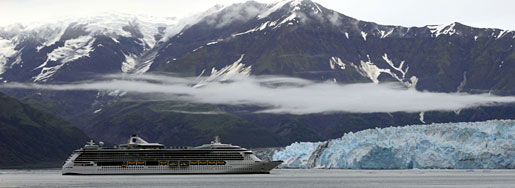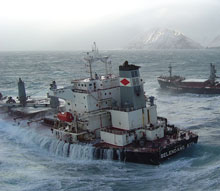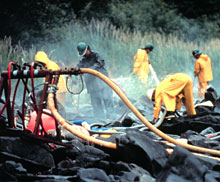

Preparing for Oil Spills in the Future Arctic
National Ocean Service
29-May-2009

The thawing of Arctic Ocean ice during summer months will lead to increased maritime transportation, tourism, and oil exploration activity. |
Within the next two decades, scientists estimate that the Arctic Ocean will be free of multi-year ice in the summer.
The thawing of Arctic Ocean ice during summer months will lead to increased maritime transportation and tourism. It will also lead to increased oil and gas exploration as access to Arctic sea floors grows easieróthe U.S. Geological Survey estimates that the Arctic may hold as much as 90,000 billion barrels of oil, 669 trillion cubic feet of natural gas, and 44 billion barrels of natural gas liquids, with 84 percent in offshore locations.
While many people around the world are thinking about the economic opportunities that may open up as the ice thaws, experts from the NOS Office of Response and Restoration are now working out strategies to deal with the increased likelihood of oil spills in this remote region.
The Problem
 In 2004, the M/V Selendang Ayu spilled more than 350,000 gallons of oil into the Bering Sea during a storm. Attempts to recover oil during spills in Alaska have often failed and, in many cases, weather and other adverse conditions prevent any response at all. Oil spills in Alaska have killed birds, tainted shellfish, fouled shorelines, and contributed to declines of fish populations. |
"The U.S. is not adequately prepared to respond to a large spill in broken ice conditions in the Arctic and sub-Arctic region," said Dr. Amy Merten, co-director of the Office of Response and Restoration's Coastal Response Research Center.
"The challenges of geography, weather, and a sensitive and changing ecosystem compel us to improve our preparedness and response capabilities. The increasing likelihood of a major spill in the Arctic means that we must prepare now," she said.
Since the Arctic is remote and undeveloped, vessels transiting the region will have little or no emergency response infrastructure or support. Spills that might be cleaned up relatively quickly and efficiently along the coastal U.S. will be much harder to deal with in the far reaches of the Arctic. Added to this, there are no nearby search and rescue teams in the area. Ships that collide with floating ice or other vessels will likely have to wait much longer for help to arrive.
The extreme remoteness of the Arctic also means that there are no nearby logistical support services for salvage and emergency response, so even a minor breakdown could lead to a large spill. And while technological improvements have reduced the potential for oil spills from oil production platforms, spills resulting from the associated vessel traffic, pipelines, shore side facilities and other infrastructure are common.
In addition, shoreline erosion and the melting of permafrost are dramatically affecting the stability and safety of communities in the Arctic region. Oil pipelines and other infrastructure located in permafrost will become less stable, also increasing the risk of spills.
Melting ice will also present hazards to navigation, to include unpredictable ice conditions, moving ice floes, unsettled weather, and erratic wave patterns.
Finding Solutions
 With the loss of 11 million gallons of oil, the 1989 Exxon Valdez spill in Alaska's Prince William Sound remains the largest marine spill ever to occur in U.S. coastal waters. Although the spill occurred in calm seas and ice-free conditions with response equipment and shore-based infrastructure available nearby, the clean-up was still daunting. Active response efforts took over three years. Today, 20 years later, the environment and communities are still recovering. |
NOAA is now working with Norway, the University of Alaska, the Prince William Sound Oil Spill Recovery Institute, and the University of Rhode Island to address these concerns. The goal of ongoing research is to better understand and prepare for conditions and increased traffic in the Arctic in the not-too-distant future.
This work is part of a larger joint industry program to improve response capabilities and contingency plans for responding to Arctic spills.
NOAA also recently co-led an international workshop on accident threats to the Arctic. The key recommendations from this workshop are forming OR&Rís Arctic Preparedness and Response Strategy:
- Enhance and add capacity for spill preparedness and response capabilities for the Arctic/Sub-Arctic regions. Currently, response assets would come from Anchorage and the lower 48 states, taking days to weeks to arrive on scene.
- Develop response strategies for using alternative countermeasures (e.g., dispersants, in-situ burning).
- Update environmental sensitivity maps, improve baseline data for biological resources at risk and other planning tools for emergency responders.
- Conduct critical research on Arctic response and restoration efforts including better understanding of behavior and effects of oil in cold water/ice conditions and the technologies for spill response in difficult environments.
- Develop pollutant fate and effects models (models that help predict what will happen to pollutants and what effects they may have on the environment) for ice conditions.
- Develop natural resource damage assessment and restoration guidelines/protocols for the Arctic.
Source: http://oceanservice.noaa.gov/news/features/jun09/arctic.html
Posted by Arthur Caldicott on 02 Jul 2009